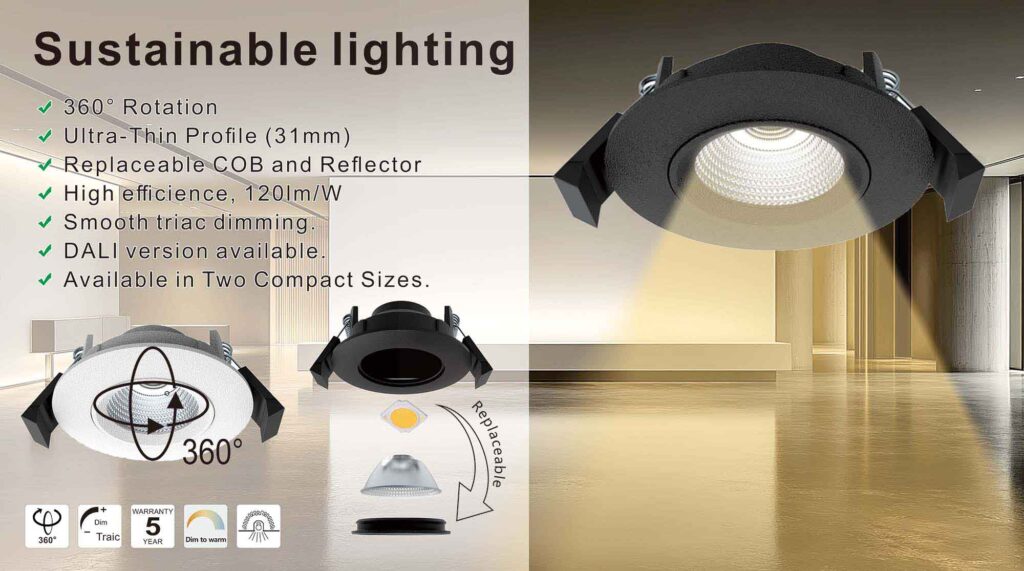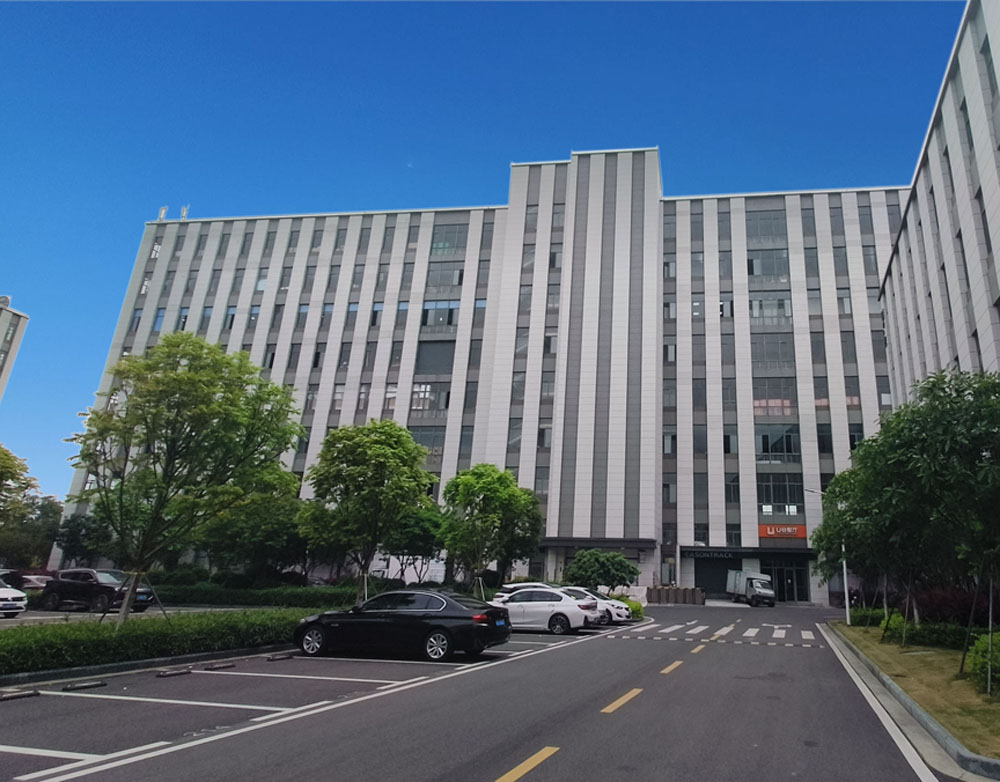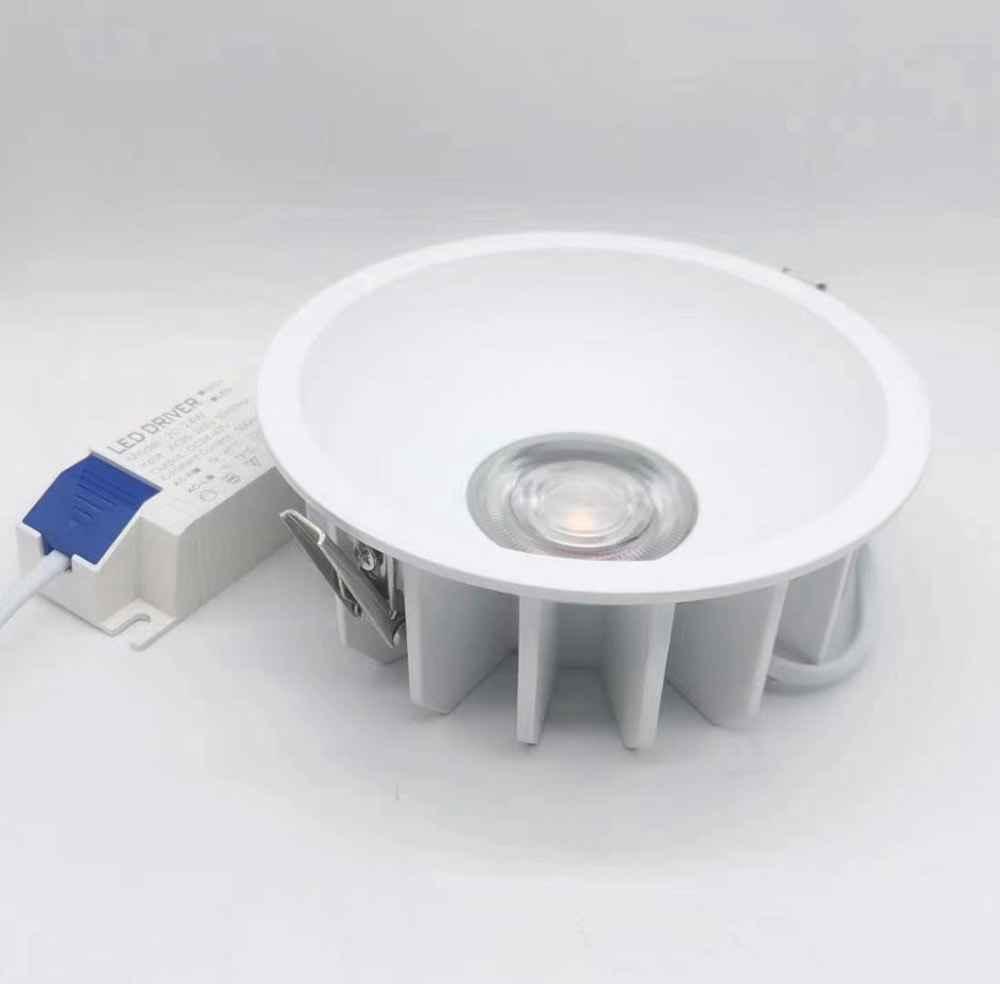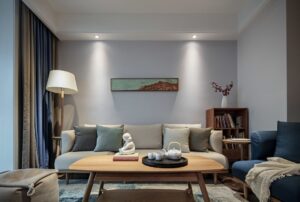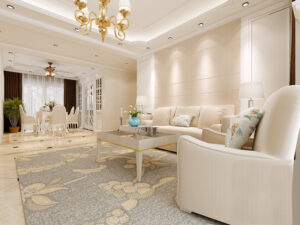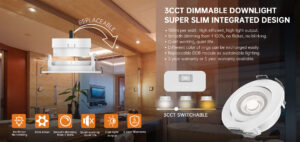At vælge den rigtige downlight til dit rum er en vigtig beslutning, der påvirker både funktionalitet og atmosfære af dit indendørsmiljø. Downlights er en populær belysningsløsning i hele Europa og foretrækkes for deres evne til at give ren og diskret belysning.
Blandt de mange tilgængelige muligheder, faste downlights og justerbare tilt downlights skiller sig ud som to primære typer, der hver især tilbyder unikke fordele, der er skræddersyet til forskellige belysningsbehov.
Denne omfattende guide vil udforske forskellene mellem disse to downlight-typer, deres anvendelser og hvordan du vælger den bedste løsning til dit projekt i 2025.
Downlights er indbyggede eller overflademonterede lyskilder, der er installeret i lofter og giver fokuseret eller omgivende belysning uden at optage visuel plads. De er blevet en fast bestanddel af belysning til boliger, virksomheder og hoteller og restauranter på grund af deres elegante design og energieffektive LED-teknologi.
I takt med at belysningsstandarder udvikler sig, især i Europa, stiger efterspørgslen efter højtydende, brugerdefinerbare downlights. Forståelse af forskellene mellem faste og justerbare vippe-downlights kan hjælpe dig med at optimere belysningsdesignet, samtidig med at du overholder de nyeste energi- og sikkerhedsforskrifter.
Faste downlights: Enkelhed og ensartethed
Faste downlights er designet med en stationær lyskildeNår de er installeret, forbliver deres stråleretning konstant, hvilket giver ensartet, ensartet belysningDette gør dem ideelle til generel stemningsbelysning i rum som stuer, gange, kontorer og soveværelser.
Deres minimalistiske design sikrer en rent loftudseende, hvilket stemmer overens med moderne europæiske æstetiske præferencer for subtilitet og raffinement.
Fordele ved faste downlights
- Nem installation: Faste downlights kræver mindre præcis positionering, hvilket reducerer installationstid og omkostninger.
- Omkostningseffektivitet: Deres enklere design betyder typisk en lavere startpris sammenlignet med justerbare modeller.
- Ensartet belysning: De producerer ensartet lysfordeling, hvilket er ideelt til generelle belysningsbehov.
- Lav vedligeholdelse: Færre bevægelige dele betyder mindre slitage over tid.
Begrænsninger
- Manglende fleksibilitet: Faste downlights kan ikke omdirigeres, hvilket begrænser deres anvendelse til accent- eller arbejdsbelysning.
- Potentiale for skygger: I områder, der kræver fokuseret lys, giver faste downlights muligvis ikke tilstrækkelig belysning.
Justerbare vippe-downlights: Alsidighed og kontrol
Justerbare vippe-downlights har en drejemekanisme der gør det muligt at styre lysstrålen derhen, hvor det er nødvendigt. Denne fleksibilitet gør dem perfekte til accent belysning, der fremhæver kunstværker, arkitektoniske detaljer eller specifikke zoner i et rum. De bruges i vid udstrækning i detailhandel, gallerier, køkkener og hotel- og restaurationsmiljøer, hvor dynamisk belysning er afgørende.Fordele ved justerbare vippe-downlights
- Retningsbelysning: Evne til at fokusere lys præcist på objekter eller områder.
- Dynamisk atmosfære: Juster belysningsvinklerne for at skabe stemning eller fremhæve elementer.
- Alsidighed: Velegnet til både omgivende belysning og arbejdsbelysning.
- Designappel: Deres funktionelle design tilføjer et lag af sofistikering og tilpasningsevne.
Begrænsninger
- Højere omkostninger: Mere kompleks mekanik og design øger prisen.
- Installationskompleksitet: Kræver omhyggelig justering og sommetider professionel installation.
- Opretholdelse: Bevægelige dele kan have brug for lejlighedsvis justering eller reparation.
Sammenligning af faste og justerbare vippe-downlights
| Feature | Faste downlights | Justerbare vippe-downlights |
|---|---|---|
| Stråleretning | Fast, ikke-bevægelig | Justerbart, drejeligt hoved |
| Bedste brug | Generel omgivende belysning | Accent- og arbejdsbelysning |
| Installationsvanskeligheder | Enkel og hurtig | Mere kompleks, kræver muligvis professionel hjælp |
| Koste | Lavere startomkostninger | Højere startomkostninger |
| Æstetisk | Minimalistisk, ensartet loftsudseende | Funktionel med synlig justeringsfunktion |
| Opretholdelse | Lavt antal bevægelige dele | Moderate, bevægelige dele kræver pleje |
| Energieffektivitet | Høj (LED-muligheder tilgængelige) | Høj (LED-muligheder tilgængelige) |
| Fleksibilitet | Lav | Høj |
Vigtige overvejelser ved valg mellem faste og justerbare vippe-downlights
Formålet med belysning
Det er vigtigt at forstå din belysnings primære funktion. Faste downlights udmærker sig ved at levere generelt omgivende lys der oplyser et rum jævnt. Justerbare, vippebare downlights er bedre egnet til fremhævning af specifikke funktioner eller at sørge for arbejdsbelysning i områder som køkkener eller arbejdsområder.Værelsets karakteristika
- Lofthøjde: Ved standard lofthøjder (2,4 til 3 meter) kan faste downlights med bredere strålevinkler (omkring 60°) give tilstrækkelig dækning. Justerbare downlights med vippefunktion er fordelagtige i rum med højere lofter, eller hvor der kræves fokuseret lys.
- Værelsesstørrelse: Større rum drager fordel af en blanding af faste downlights til omgivende belysning og justerbare, vipbare downlights til at fremhæve områder.
- Rumfunktion: I stuer og soveværelser anvendes typisk faste downlights for at opnå et blødt og ensartet lys. I køkkener, gallerier og butikslokaler er der ofte brug for justerbare downlights med vippefunktion for at opnå målrettet belysning.
Strålevinkel og lysfordeling
De strålevinkel bestemmer, hvordan lyset spredes fra downlighten. Faste downlights leveres normalt med faste strålevinkler, typisk omkring 40° til 60°, hvilket er egnet til omgivende belysning. Justerbare downlights med vippefunktion giver dig mulighed for at ændre stråleretningen, men har normalt lignende strålevinkelområder.| Strålevinkelkategori | Gradområde | Typisk brug |
|---|---|---|
| Meget smal plet | 5° – 15° | Fremhævning af små objekter |
| Smal plet | 16° – 25° | Accent belysning |
| Medium | 25° – 40° | Opgavebelysning |
| Bred oversvømmelse | 41° – 60° | Generel omgivende belysning |
| Meget bred oversvømmelse | 60° – 120° | Bred belysning af området |
Energieffektivitet og overholdelse
Med den ENERGY STAR Downlights Specifikation Version 1.0 Fra januar 2025 skal belysningsprodukter opfylde strengere kriterier for energieffektivitet og ydeevne. Både faste og justerbare vippe-downlights bruger nu almindeligvis LED-teknologi, som giver overlegne energibesparelser og levetid sammenlignet med traditionel belysning. EU's Ecodesign-regler kræver også udfasning af ineffektiv belysning, hvilket skubber markedet mod LED-downlights med høj lysudbytte (over 120 lm/W i nogle lande inden 2025). Når du vælger downlights, skal du sørge for, at produkterne overholder disse standarder for at drage fordel af energibesparelser og kvalificere dig til certificeringer.Radians Lighting: Ekspertise inden for design og fremstilling af downlights
Radians belysning er en fremtrædende europæisk producent med speciale i LED-downlights og tilbyder et bredt udvalg af faste og justerbare vippe-downlights, der er skræddersyet til at imødekomme forskellige belysningsbehov. Virksomheden lægger vægt på tilpasning, designinnovation og streng kvalitetskontrolhvilket gør den til en betroet partner for belysningsmærker og forhandlere i hele Europa.Produkttilpasning
Radians tilbyder omfattende tilpasningsmuligheder, herunder:- Justering af strålevinkel for at passe til specifikke rumstørrelser og loftshøjder.
- Farvetemperaturvariationer fra varm hvid (2700K) til kølig hvid (5000K), hvilket giver en skræddersyet atmosfære.
- Dæmpbare muligheder kompatibel med forskellige styresystemer.
- Afslutninger på trim såsom hvid, sort, børstet stål og krom, der matcher indretningen.
Design og kvalitetskontrol
Radians integrerer banebrydende LED-teknologi med omhyggelige designprocesser for at sikre optimal lysfordeling, lav blænding og energieffektivitet. Deres produkter gennemgår strenge tests for at opfylde europæiske standarder, herunder IP-klassificeringer for fugtbestandighed og IC-klassificeringer for isoleringskompatibilitet.Produktkategorier relevante for valg af downlight
- Faste LED-downlightsDesignet til ensartet omgivende belysning.
- Justerbare vippe-downlightsTilbyder retningsbestemt lysstyring.
- Dæmpbare downlightsTil humør- og energikontrol.
- Anti-refleks downlightsFor at reducere øjenbelastning.
- Vandtætte downlightsVelegnet til badeværelser og udendørs områder.
Tekniske specifikationer at overveje
Lumenudbytte og effekt
Lumen måler mængden af lys, der udsendes, mens watt angiver energiforbruget. Moderne LED-downlights tilbyder høje lumen pr. watt, hvilket betyder klart lys med lavt strømforbrug.| Effekt (W) | Typisk lumenudbytte | Anvendelse |
|---|---|---|
| 3W | 200 – 300 lm | Accentbelysning, små rum |
| 6W | 400 – 600 lm | Arbejdsbelysning, køkkener |
| 9W – 12W | 700 – 1000 lm | Generel omgivende belysning |
| 15W+ | 1200+ lm | Store værelser, erhvervslokaler |
farvegengivelsesindeks (CRI)
CRI angiver, hvor præcist en lyskilde viser farver sammenlignet med naturligt lys. Til bolig- og erhvervslokaler anbefales en CRI på 80 eller derover, mens 90+ foretrækkes til detailhandel eller gallerier.IP- og IC-klassificeringer
- IP-vurdering: Definerer beskyttelse mod støv og vand. IP20 er almindelig til indendørs tørre områder, mens IP44 eller IP65 bruges til badeværelser eller udendørs installationer.
- IC-vurdering: Angiver om en downlight kan installeres sikkert i kontakt med isolering, hvilket er vigtigt for energieffektivitet og brandsikkerhed.
Installationstips og bedste praksis
- Planlæg layoutet: Bestem antallet og afstanden mellem downlights baseret på rummets størrelse, loftshøjde og ønskede lysniveauer.
- Vælg kompatible lysdæmpere: For dæmpbare downlights skal du sørge for, at lysdæmperne matcher LED-specifikationerne for at undgå flimmer.
- Overvej strålevinkler: Brug bredere vinkler til omgivende belysning og smallere vinkler til accentbelysning.
- Professionel installation: Især for justerbare downlights med vippefunktion sikrer professionel installation optimal justering og overholdelse af sikkerhedsforskrifter.
Casestudier: Valg af downlights til forskellige rum
Boligstue
- Faste downlights Med en strålevinkel på 60° giver den et blødt og jævnt lys.
- Bruge dæmpbare muligheder at justere stemningen.
- Tilføje justerbare tilt downlights nær kunstværker eller læseområder for fokuseret lys.
Kommerciel detailbutik
- Installere justerbare tilt downlights at fremhæve varerne.
- Brug faste downlights til generel gulvbelysning.
- Vælg høj CRI (90+) for at forbedre produktfarverne.
Gæstfrihed (hotellobby)
- Kombiner faste downlights til stemningsbelysning med justerbare, vippebare downlights for at fremhæve arkitektoniske træk.
- Vælge modeller med antirefleks for at forbedre gæsternes komfort.
- Brug dæmpbare downlights til at styre stemningen på forskellige tidspunkter af dagen.

